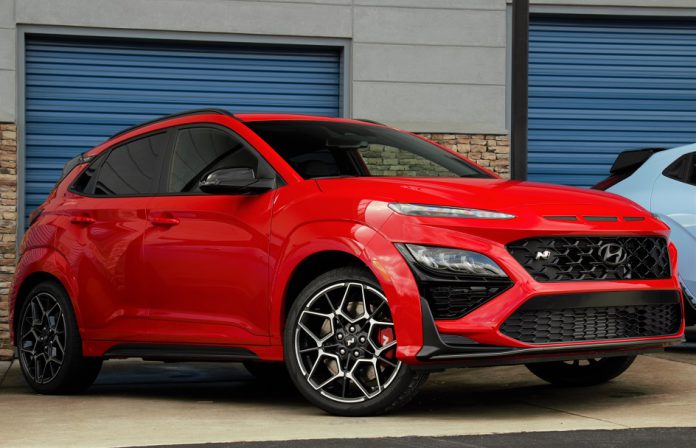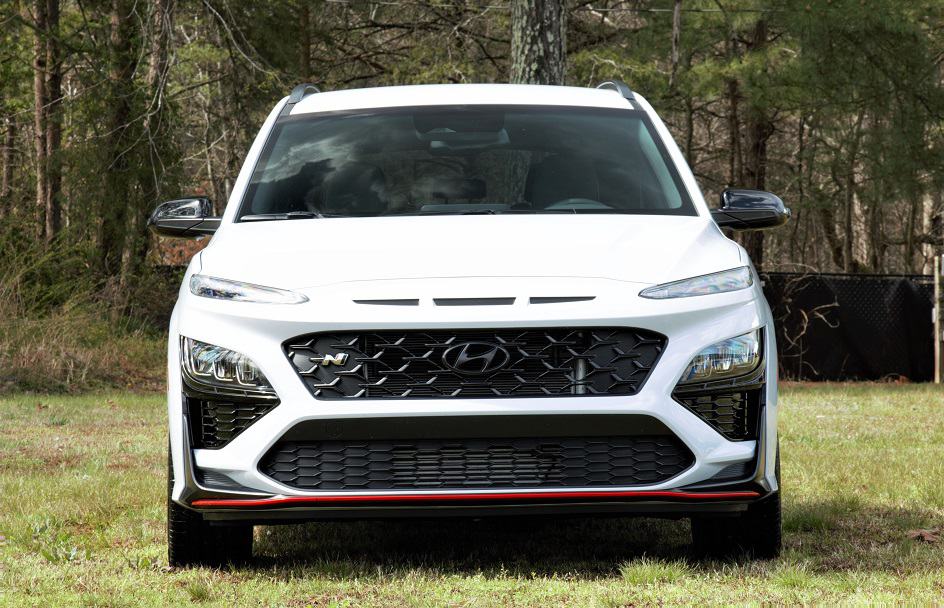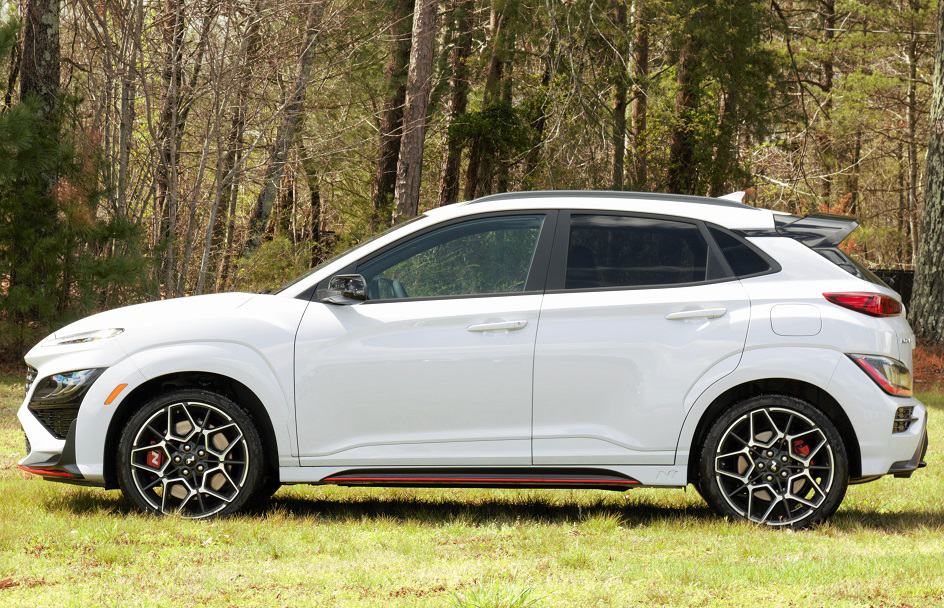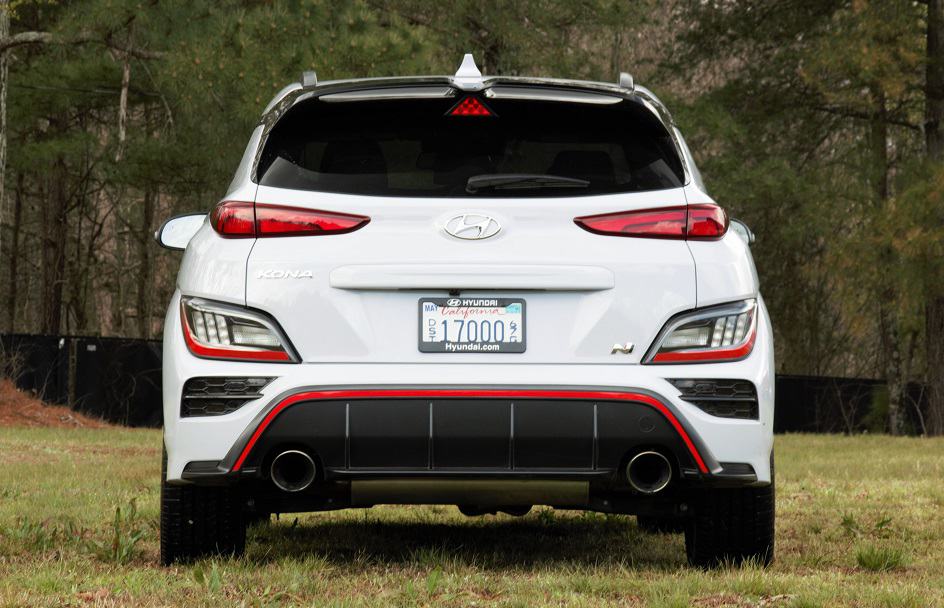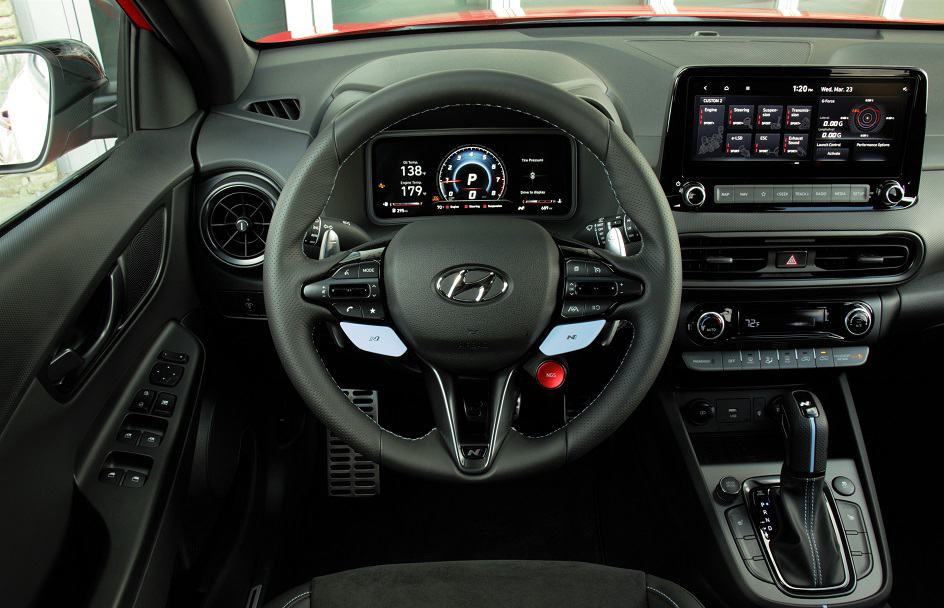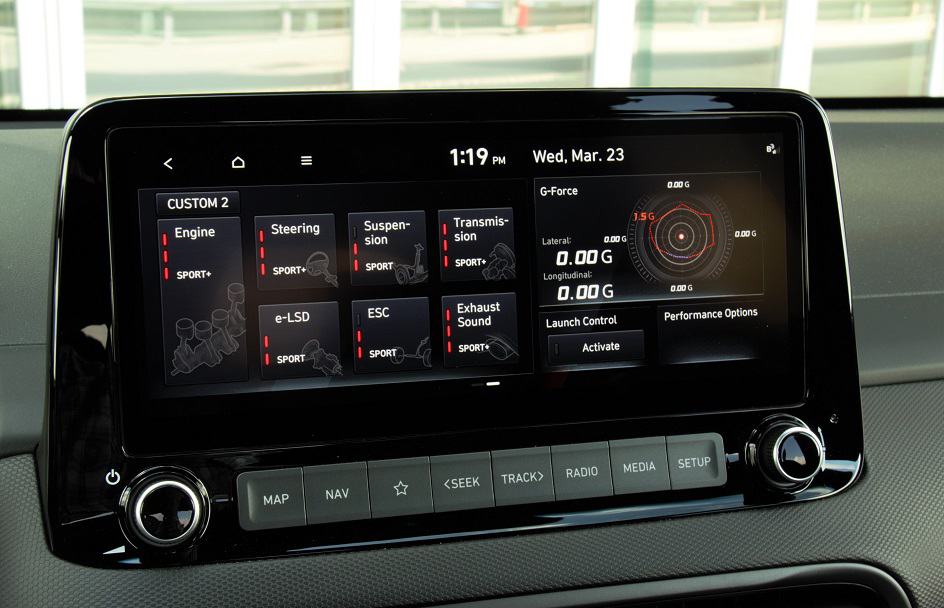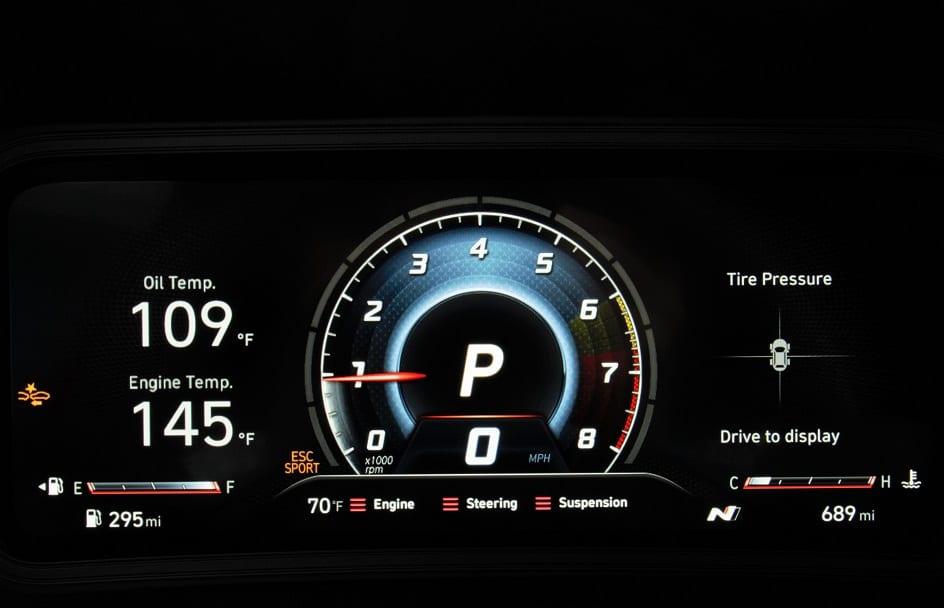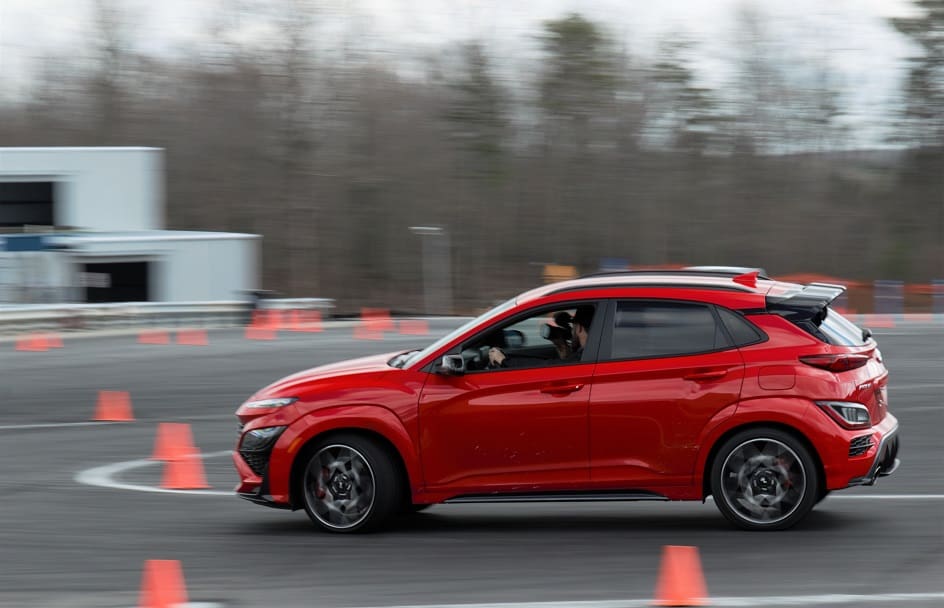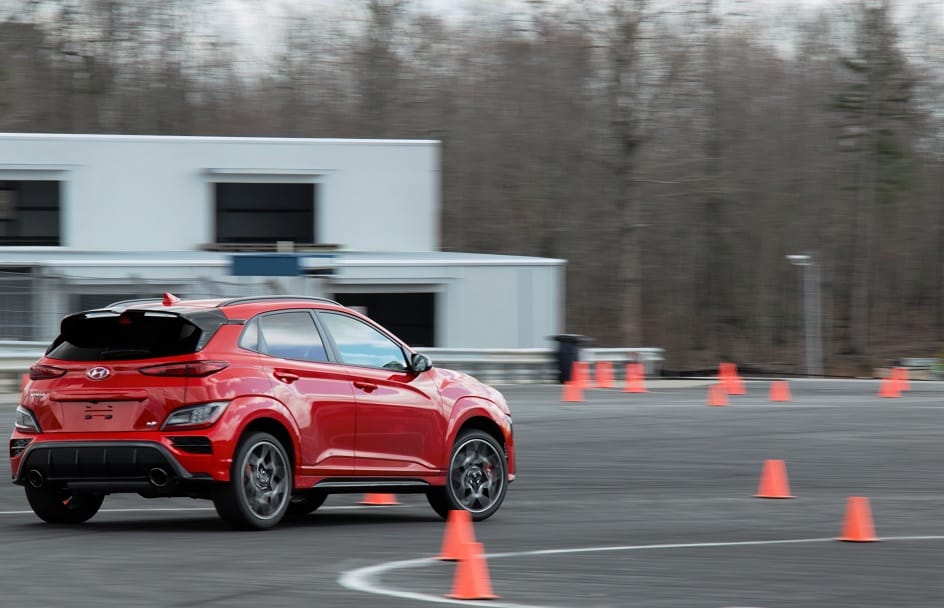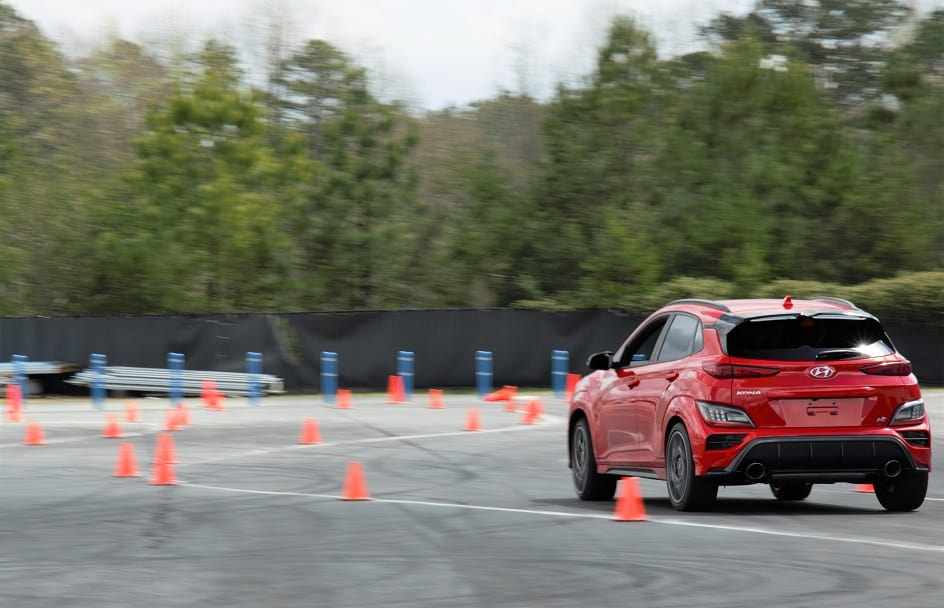As part of its ongoing effort to encourage its customers to “Never Just Drive,” last year Hyundai released the first-ever N versions of its Kona compact SUV and Elantra compact. Of course, those can function perfectly well as commuter vehicles just like their more mild-mannered siblings, but Hyundai modified and upgraded them in key areas so that they can be used at the track. To showcase the newest members of the N group of vehicles, Hyundai invited me and several of my colleagues from other publications to test out the Kona N and Elantra N at the Atlanta Motorsports Park, a challenging two-mile road course full of tight curves, rapid transitions, blind turns, and up to 100 feet of elevation change. They broke us into four groups and rotated us through a lead/follow session on the track, an autocross course, and time on the winding back roads near the complex. In this first installment of my two-part coverage, I’ll focus on my time in the 2022 Hyundai Kona N.
THE VEHICLE
Over the past several years, Hyundai has expanded its performance portfolio through its N Line series of models, which feature different exterior and interior styling across the range and an array of enhancements for the Elantra and Sonata sedans, and all-out N variants, which come with more aggressive design, engine, suspension, interior upgrades. The first N model to hit the U.S. market was the Veloster N, a three-door hot hatch with 276 turbocharged horsepower and an available 8-speed dual-clutch gearbox.
Though, Hyundai stayed with the small-vehicle-with-big-power theme, they have now ventured into the SUV space for the first time with the Kona N. Aside from picking one of the four exterior colors and a choice of six accessories, configuring one is a quick and easy process. All Kona Ns are front-wheel-drive and come with a black leather and microfiber interior, an 8-speed dual-clutch transmission, and the same performance hardware for a starting price of $34,200.
During Hyundai’s technical presentation, it quickly became apparent just how serious it was about transforming its modest Kona into a tire-scorcher. To make sure the Kona N’s body could handle the increased output and sharper handling, Hyundai’s engineers reinforced it with additional spots welds in key areas and added four-point strut tower rings at the front end. The Electronically Controlled Suspension consists of a McPherson strut front and multi-link rear design with special electronic dampers and N-specific springs, stabilizers, and powertrain mounts. Hyundai equips the Kona N with larger 19” x 8” wheels and a set of 245/40 Pirelli P Zero summer tires. That bump in diameter frees up room for bigger ventilated 14.2-inch front and 12.4-inch rear brakes with high-friction pads and a hydraulic pressure pre-fill function for immediate engagement.
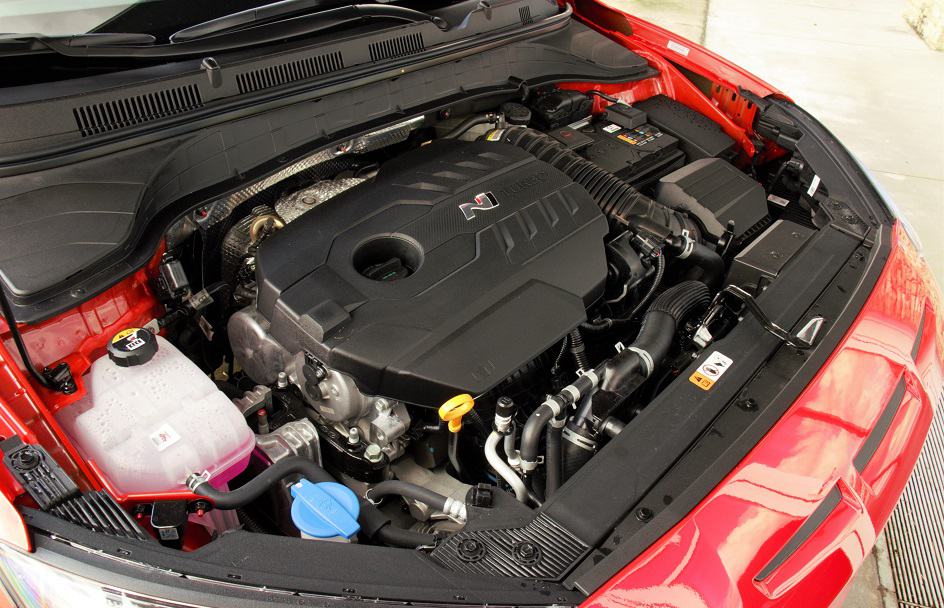
Like the Elantra N, the Kona N is powered by a turbocharged 2.0-liter four-cylinder engine with direct injection and something Hyundai calls Flat Power technology, which enables the engine to deliver maximum output across a broad range of RPMs. Horsepower technically peaks at 276 between 5,550 and 6,000 rpm, but an extra 10 can be accessed for 20 seconds by hitting the N Grin Shift turbo overboost button. Torque hits a plateau of 289 lb-ft at 2,100 rpm and stays there until 4,700 rpm. An 8-speed wet dual-clutch gearbox sends all of that to the front wheels. Hyundai moved the power steering motor to the bottom of the steering rack so that the Kona N’s upsized wheel and tire combo can change directions more efficiently. The N Corner Carving Differential, a.k.a. electronic limited-slip differential, routes more power to the outer wheel in a turn to combat understeer and help the Kona N follow a tighter driving line. Wherever the Kona N goes, it broadcasts its presence through a variable exhaust system with a deep, guttural burble and post-combustion bangs and pops.
The transmission has some tricks of its own. Launch Control requires hitting a button on the 10.25-inch infotainment touchscreen, pinning the brake pedal with your left foot, stabbing and flooring the accelerator pedal with your right foot until the revs hit the perfect level, then letting off the brakes. The N Power Shift function maximizes torque during upshifts above 6,000 rpm when more than 90 percent throttle is applied. The DCT can even tell when the Kona N is on a track by deciphering inputs such as g forces and steering angle, which it then uses to plot its shift points.
The visual differences between the Kona N and the milder gas-powered Kona models (except the N Line) are just as numerous. On the front of the car, three horizontal slits take the place of the Hyundai badge, which gets moved to the middle of the black mesh grille. That sits above a more pronounced lower front fascia. Body-color fender flares highlight the upsized wheels and tires. At the rear, the liftgate-mounted spoiler swoops out over the triangular high-mounted center stop light. A pair of large-bore dual exhaust finishers punctuate both ends of the N-specific lower rear fascia.
Inside, the major touchpoints make it clear that the Kona N is not the average compact SUV. Performance Blue buttons attached to the steering wheel provide access to full N driving settings and custom modes with configurable engine, steering, suspension, transmission, differential, Electronic Stability Control, and exhaust sound settings. The big red button under the right spoke engages the N Grin Shift overboost function. Larger bolsters on the front racing inspired sport seats are there to provide support during hard turns – which were plentiful at the track.
THE DRIVE
Several of my colleagues and I jumped into our separate Kona N test cars for a lead/follow session guided by a Hyundai factory driver on the rain-slicked road course. Despite all of the hardware the Kona N shares with its sedan sibling, there was no hiding its physical differences. Almost immediately, its higher center of gravity became apparent. Sheer physics kept it from feeling as button-downed as the Elantra N, but they also made it a hoot to drive, even if I wasn’t nailing every apex. I quickly learned to love every degree of body lean and enjoy the sensation of the car starting to slide. The track’s numerous turns revealed how useful the thumb bumps in the steering wheel can be and how much lighter the Kona N feels on its feet compared to the Elantra N.
A large open slab of pavement served as our autocross course. Its short straightaways didn’t give me much time to unleash the Kona N’s full power, but I didn’t mind because it was more fun in the turns, anyway. Luckily, I had plenty of opportunities to dart through those and discover the advantages of the Kona N’s compact dimensions. Its 102.4-inch wheelbase and short overhangs made it easy to bend the vehicle around the cones without worrying about getting a grille full of orange rubber.
Later in the day, I took the Kona N out on the tree-lined winding roads near the facility. I was soon reminded of Hyundai’s presentation that morning and the three pillars of the N brand: Racetrack Capability, Everyday Sports Car, and Corner Rascal – particularly the last one. Many times, it’s easy to dismiss corporate buzzwords as verbal fluff, but the faster I went down that instantly addictive, seemingly unending series of S-bends, the more I became convinced that Hyundai had chosen a fitting name for one of the core tenets of its performance sub-brand and created a vehicle that embodied it. Not only was the Kona N ready for high-rpm blasts and quick direction changes at increasingly thrilling speeds, but its mischievous nature rubbed off on me. The second there was more than a few yards of straight pavement in front of me, I shoved my right foot down and let out all of the turbo 2.0’s manic, bear-in-a-breadbox power. The Kona N ripped forward with a shocking ferocity and a satisfying raspy buzz. I was hooked. The curves only intensified the rush. The second I felt the body leaning on the suspension, I pushed down on the throttle even harder. My aggression only made the Kona N dig in deeper. I somehow instantly knew that it could take what I was throwing at it, that I was going to lose my nerve (and/or license) before it broke a sweat.
I must admit that I initially underestimated the Kona and Elantra N models. I knew they would be more focused and athletic, but I didn’t realize how fundamentally and extensively Hyundai had altered them in their quest to make driving about more than just commuting. The Kona N was just a start, though. Hyundai’s N brand performance mongers went even further with the Elantra N, which I’ll cover in Part 2.



